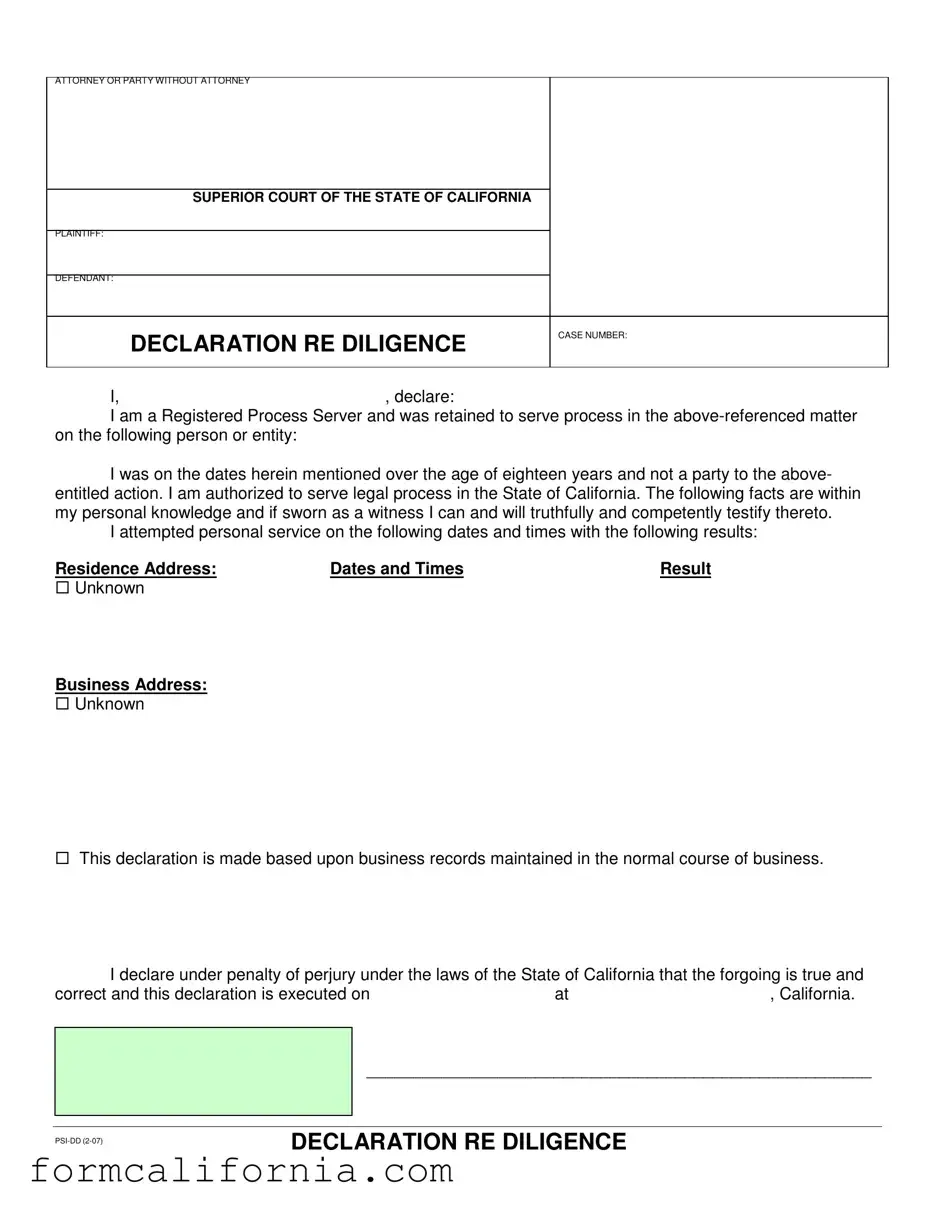The California Diligence form is designed to document the efforts made by a process server to deliver legal documents in a case. Similar in purpose and function is the Proof of Service form, which also plays a crucial role in the legal process. While the Diligence form records the attempts made to serve legal papers, the Proof of Service form confirms that the documents have indeed been delivered to the relevant party. Both documents ensure transparency and accountability in the legal process, providing an official record that service attempts were made or completed as required by law.
Another document bearing similarity is the Affidavit of Service. Like the Diligence form, it serves as a sworn statement, often provided by a process server, detailing how, when, and where legal documents were served to a party involved in legal proceedings. The key difference is that while the Affidavit of Service confirms successful delivery, the Declaration re Diligence details attempts made when direct service has not been successful, highlighting the efforts to comply with service requirements.
The Summons form is another crucial legal document closely related to the California Diligence form. It notifies the defendant about the legal action against them and includes details on how and by when they must respond. The link between the two forms lies in their shared role in the process service phase of legal proceedings, ensuring the defendant is properly informed about the case and the attempts made to serve them.
The Subpoena form, used to compel attendance at a court hearing or deposition and to request documents, shares similarities with the Diligence form in its legal service process. Both require a meticulous approach to documenting the process server's efforts to locate and serve the document to the right individual, ensuring that legal proceedings can continue without delay due to procedural issues.
Similar to the California Diligence form is the Notice of Hearing, which informs parties of the time and place of a court hearing. Both documents are essential to maintaining the procedural fairness of the legal system, making sure that all parties are adequately informed and have the opportunity to participate in proceedings. They share the principle of ensuring due diligence in the legal notification process.
The Writ of Execution form, which allows for the enforcement of a court's judgment, often requires the services of a process server to deliver the document to the party facing enforcement. The connection with the Dilignce form lies in the documentation of efforts to serve the Writ, especially in challenging cases where parties might be evasive, underscoring the importance of persistence and thorough documentation in legal proceedings.
A document serving a similar purpose to the California Diligence form is the Request for Entry of Default, used when a defendant fails to respond to a lawsuit within the designated timeframe. This form often follows the Diligence form in cases where attempts to serve a defendant are unsuccessful, leading to the next step in the legal process without their response. Both documents mark critical steps in advancing legal proceedings despite challenges in notification and response.
The Temporary Restraining Order (TRO) form, which provides short-term protection by the court in urgent situations, closely aligns with the Diligence form concerning service requirements. The critical nature of timely and effective service in cases involving TROs highlights the importance of diligent efforts to locate and serve individuals, mirroring the documentation of attempts captured in the Diligence form.
Lastly, the Declaration under Uniform Child Custody Jurisdiction and Enforcement Act (UCCJEA) shares similarities with the California Diligence form, as it pertains to child custody matters and requires careful documentation of parties' locations and attempts at service. Both forms are vital in their respective areas, ensuring legal processes are followed meticulously and that all parties are treated fairly and impartially.

